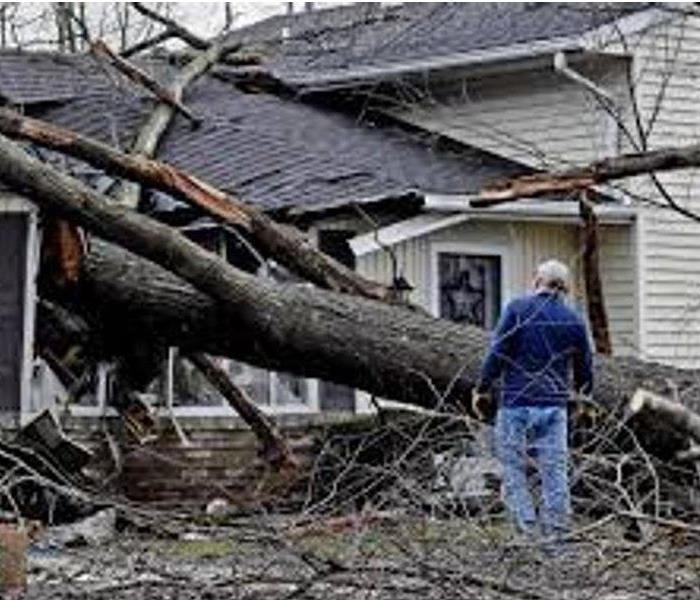How To Know It’s Time To Call A Storm Damage Restoration Company
4/5/2022 (Permalink)
 Storms can happen in a flash. Let SERVPRO of Streamwood, Bartlett, West Chicago, and Warrenville help when storm damage is severe.
Storms can happen in a flash. Let SERVPRO of Streamwood, Bartlett, West Chicago, and Warrenville help when storm damage is severe.
The weather conditions in Illinois can easily result in storms. As a result, your home or property may receive damage. One example of damage after stormy weather is roof damage. This may result in roof leaks and further damage.
Here are some signs that you should call SERVPRO of Streamwood, Bartlett, West Chicago, and Warrenville.
1. Wind damage
Winds that accompany a storm can be devastating. This type of damage is what you should first look for after a storm. Here are some signs of wind damage to let you know that it is time to call.
- Missing shingles: Missing shingles is one obvious sign of wind damage. Already peeling or cracked shingles are even more susceptible. New and well-maintained roofs are less at-risk. Some roofing manufacturers also have warranties that cover severe wind damage.
- Visible loss of granules: Commonly, brand new roofs suffer some granule loss. The loss of granules is found in characteristic horizontal lines with storm damage. This is a sign of a broken shingle seal. As shingles flap in the wind, granules rub off.
- Visible water infiltration: Leaks that penetrate through the ceilings are obvious signs of wind damage. This is true if you see a water stain on your ceiling. If this happens, it means that both the roof underlayment and shingles are compromised.
- Loose debris: Loose debris after a storm can also be an indication of wind damage. If your roof is struck by elements because of the high winds, you will likely find debris in and around your home. Ensure that you clear all debris to reduce the safety risk.
2. Snow and hail damage
Hail forms at the same range of temperature at which snow is possible. Hail consists of compact-sized balls of ice. They are capable of denting or punching through solid objects when they fall at full force. Here are some signs of hail and snow to let you know that the service of a storm damage restoration company is needed:
- Damaged or missing shingles: Hail can cause the immediate loss of shingles even if they were intact before a storm. Look for dents and cracks to find the location of the impact. The shingles may need replacement because of the damage, even if they are still present.
- Broken or clogged gutters: Clogged gutters should be cleaned immediately after a storm. This is to allow water to drain properly away from the foot of the building. If it does not, the foundation of your house can get eroded, making the structure unsafe. Ensure that all downspouts and gutters are not broken or clogged. If they are, call a restoration company.
- Ice dams: Shingles become vulnerable to ice dams when not properly maintained. Ice dams form due to the freezing of melted snow on the eaves of your roof. Ice dams can prevent the proper flow of water off your roof, encouraging leaks. An ice dam is an issue you can easily notice.
3. Water damage
Water damage is unlike wind and hail damage. Sometimes, it takes a while before water damage gets noticed. However, it can still lead to serious damage to your health and home if not addressed. You should call a storm damage restoration company if you notice any of these signs:
- Damage to roof accents or supports: Damage to the supporting structures of your home may not be obvious. Your shingles may also appear to be intact. However, ensure that you look for areas where there is heavy pooling of water after or during heavy rain. You should also check the chimney, flashing around vent pipes and other areas susceptible to pooling of water.
- Visible attic issue: The attic of your house is part of your home’s ecosystem. A sign of leaks you can see in your attic is moisture penetration. You may need to replace the insulation and inundated surfaces to prevent the growth of mildew and mold.
- Odd smell: You may not notice water even if there is a minor leak somewhere in the wall of your home. However, you may notice some type of smell. You will notice more serious signs of water damage if you can locate the source of the smell.
- Discoloration on the walls: Whenever there is water damage, and it is not visible, there is a high chance that the problem is going into the walls of your home. You may not easily notice dripping water as a result of small leaks. However, you will start noticing discoloration on your walls as time goes on. It is a sign of excess moisture in your home.
- Warped flooring: Warped flooring is another sign that there is unseen water in your home. The result of water getting between the floorboards is buckling and uneven flooring. To be sure of this, ensure that you check your baseboards. There could also be mold beneath them.





 24/7 Emergency Service
24/7 Emergency Service